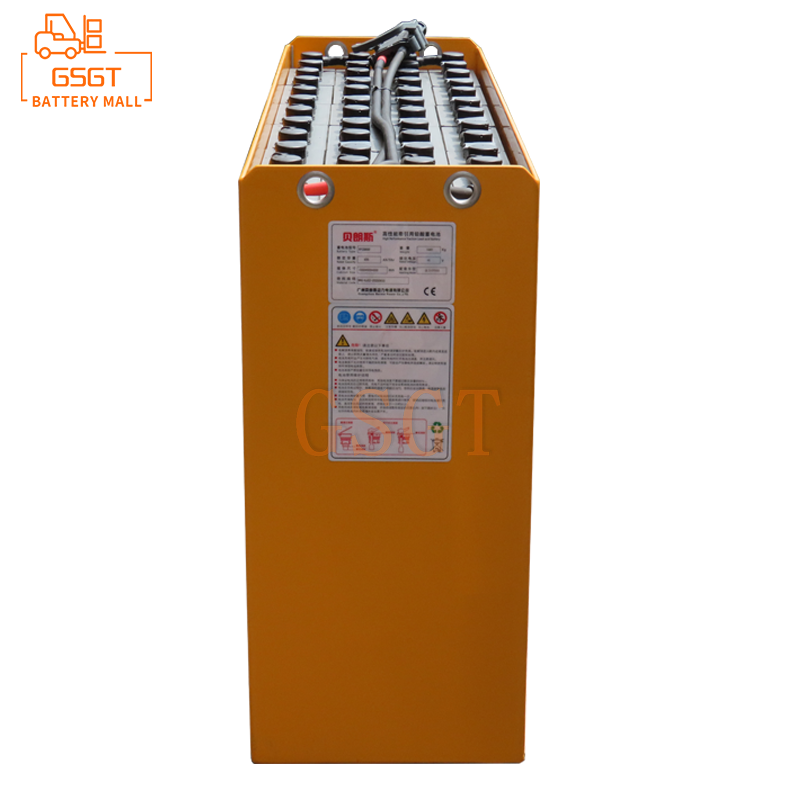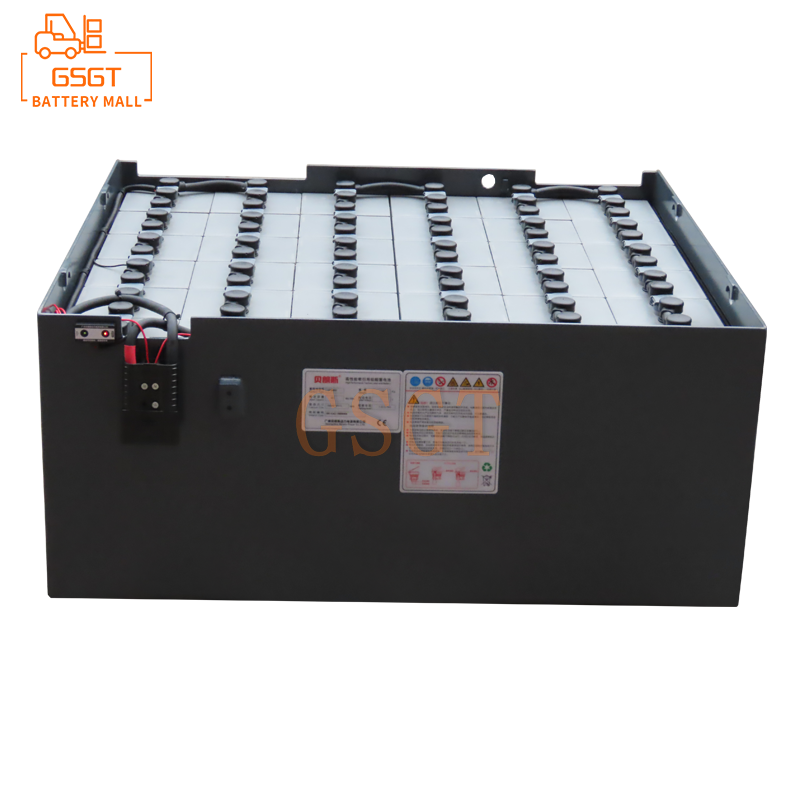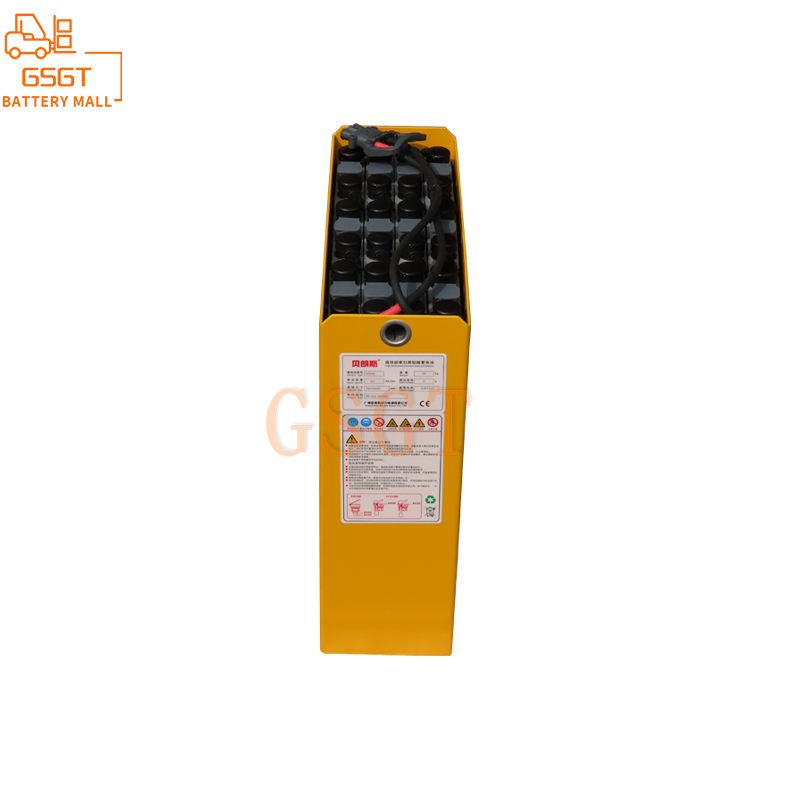Time:2025-04-22 11:48:35
Browse:509
In the modern logistics and warehousing field, forklifts, as important handling equipment, the performance and service life of their power source, lead-acid batteries, directly affect operational efficiency and operating costs. A scientific and reasonable charging strategy is crucial for extending the service life of lead-acid batteries and ensuring the stable operation of forklifts. The following will discuss in detail the scientific charging strategies for forklift lead-acid batteries.
1. Working Principle and Characteristics of Lead-Acid Batteries
Lead-acid batteries are mainly composed of positive and negative plates, electrolyte (sulfuric acid aqueous solution), separators, etc. During the discharge process, lead dioxide at the positive electrode and lead at the negative electrode undergo chemical reactions with sulfuric acid in the electrolyte, converting chemical energy into electrical energy to provide power for the forklift. During the charging process, a reverse current is applied through an external power source to make the above chemical reaction proceed in the opposite direction, converting electrical energy into chemical energy for storage.
Lead-acid batteries have the advantages of relatively low cost, mature technology and strong high-current discharge capacity, making them suitable for applications like forklifts that require short-term high-current discharge. However, it also has some limitations, such as a relatively low energy density, a high self-discharge rate, and a high sensitivity to charging conditions. If the charging strategy is inappropriate, it can easily lead to premature battery aging, capacity decline, and even malfunction.
2. Common Charging Misunderstandings and Hazards
1. ** Over-discharging before charging ** : Some operators think that forklifts can still work and continue to use them until they are completely immobile before charging them. Excessive discharge of lead-acid batteries can cause sulfation of the plates, that is, the lead sulfate crystal particles on the negative plate become larger, making it difficult for them to be reconverted into lead and sulfuric acid during the charging process. This leads to a decrease in battery capacity, an increase in internal resistance, and in severe cases, the battery cannot be charged and discharged normally, significantly shortening its service life.
2. ** Long-term Overcharging ** : Some users are worried that the battery won't be fully charged, so they continue to charge it for a long time even after the battery is fully charged. Overcharging can cause a large amount of gas to be generated inside the battery, leading to the loss of water in the electrolyte, the shedding of active substances on the plates, and accelerating the aging of the battery. At the same time, overcharging can also cause the battery to heat up, increase safety hazards, and may lead to serious accidents such as fires.
3. ** Random use of mismatched chargers ** : Different specifications and models of lead-acid batteries have specific requirements for parameters such as charging voltage and current. Using mismatched chargers, such as those with excessively high or low voltage or excessive current, can disrupt the internal chemical reaction balance of the battery, affecting its performance and lifespan. For instance, excessively high voltage can accelerate battery water loss and plate corrosion, while too low voltage may result in the battery not being fully charged.
3. Scientific Charging Strategies
(1) Seizing the right moment to charge
Charging too early will reduce the number of charge and discharge cycles of the battery and affect its lifespan. Charging too late may lead to excessive discharge. The battery level can be monitored in real time through the battery level display device on the forklift dashboard, and a reasonable charging plan can be formulated.
2. Avoid charging when the battery temperature is too high or too low. The optimal charging temperature for lead-acid batteries is around 25℃. When the temperature is above 40℃ or below 0℃, appropriate cooling or insulation measures should be taken before charging. Charging when the temperature is too high will accelerate the chemical reactions inside the battery and speed up its aging. When the temperature is too low, the chemical reaction rate of the battery slows down, the charging efficiency decreases, and it may also cause irreversible damage.
(2) Select the appropriate charger
1. Select a matching charger based on the battery's specifications and parameters. The output voltage of the charger should match the rated voltage of the battery. Generally, the rated voltage of a single lead-acid battery is 2V. Common forklift battery packs are composed of multiple single batteries connected in series, such as 24V, 48V, 80V, etc. The output voltage of the charger should be slightly higher than the rated voltage of the battery pack to ensure full charging, but it should not be too high.
2. The output current of the charger should be selected based on the battery capacity and the required charging time. Generally speaking, the charging current should not be too large. An excessive charging current will cause the battery to heat up severely and accelerate its aging. It should not be too small either. If it is too small, it will prolong the charging time and affect work efficiency. Generally, the charging current can be controlled at around 0.1-0.2C of the battery capacity (C represents the battery capacity).
(3) Charging Process Control
1. ** Constant Current charging stage ** : At the initial stage of charging, the battery is charged with a constant current. This stage can quickly recharge the battery while avoiding damage to the battery caused by excessive current. The constant current charging current is generally set at around 0.1-0.15C of the battery capacity until the battery voltage rises to a certain value.
2. ** Constant Voltage Charging stage ** : When the battery voltage reaches the set constant voltage value, it enters the constant voltage charging stage. At this point, the charging current will gradually decrease as the battery's charge increases. The battery continues to absorb electrical energy until the charging current drops to a certain extent. Generally, it is believed that when the charging current drops to 0.02-0.05C, the battery is basically fully charged.
3. ** Float charging stage ** : After the battery is fully charged, to compensate for the battery's self-discharge and keep the battery at full charge, float charging can be carried out. The float charging voltage is slightly lower than the constant voltage charging voltage, generally set at around 2.25-2.3V for a single battery (for a 12V battery pack, the float charging voltage is approximately 13.5-13.8V). The float charging time should not be too long, generally not exceeding 2 to 3 hours, to avoid overcharging.
(4) Regular maintenance charging
1. ** Equalization charging ** : During the use of lead-acid batteries, due to the performance differences among individual cells, there may be a situation where the voltages of each cell in the battery pack are unbalanced. Regular equalization charging can make the power and voltage of each individual battery tend to be consistent, thereby extending the service life of the battery pack. Equalization charging is generally carried out 1 to 2 times a month. The specific method is to increase the output voltage of the charger to a certain value (about 0.1 to 0.2V higher than the constant voltage charging voltage) after the normal charging is completed, and continue charging for 2 to 3 hours.
2. ** Activation Charging ** : As the battery usage time increases, the active substances on the plates may gradually lose their activity, resulting in a decrease in battery capacity. Activation charging can be achieved through special charging procedures, such as pulse charging, to activate the active substances on the plates and restore part of the battery's capacity. For batteries that have been in use for a long time, performing an activation charge every 3 to 6 months can help extend the battery life.
4. Safety Precautions for Charging
1. The charging site should be well-ventilated to prevent the accumulation of hydrogen gas produced during battery charging, which may cause explosions and other dangers. At the same time, the charging area should be kept away from fire sources and flammable and explosive items.
2. When connecting or disconnecting the cable between the charger and the battery, the power of the charger should be turned off first to avoid generating electric sparks and causing danger.
3. Regularly check the insulation condition of the charger and charging cable to ensure there is no damage, aging or other phenomena. If there is any damage, it should be replaced in time.
During the charging process, closely monitor parameters such as the battery's temperature, voltage and charging current. If any abnormal situation is found, stop charging immediately and carry out inspection and handling.
5. Conclusion
A scientific and reasonable charging strategy is the key to extending the service life of lead-acid batteries in forklifts, improving the working efficiency of forklifts, and reducing operating costs. By accurately grasping the charging timing, choosing the appropriate charger, strictly controlling the charging process, regularly conducting maintenance charging, and paying attention to charging safety, the performance and reliability of lead-acid batteries can be effectively enhanced, providing stable power support for the logistics and warehousing operations of enterprises. In practical applications, enterprises and operators should fully understand the characteristics of lead-acid batteries, follow scientific charging strategies, ensure that the lead-acid batteries of forklifts are always in good working condition, and achieve a win-win situation of economic benefits and equipment performance.

$3810

$4045

$1270

$2140

MESSAGE
Professional And Efficient
Security
Affordable Price
Professional Services